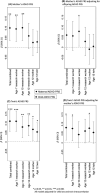Mother's and children's ADHD genetic risk, household chaos and children's ADHD symptoms: A gene-environment correlation study
- PMID: 35833717
- PMCID: PMC9796059
- DOI: 10.1111/jcpp.13659
Mother's and children's ADHD genetic risk, household chaos and children's ADHD symptoms: A gene-environment correlation study
Abstract
Background: Chaotic home environments may contribute to children's attention-deficit hyperactivity disorder (ADHD) symptoms. However, ADHD genetic risk may also influence household chaos. This study investigated whether children in chaotic households had more ADHD symptoms, if mothers and children with higher ADHD genetic risk lived in more chaotic households, and the joint association of genetic risk and household chaos on the longitudinal course of ADHD symptoms across childhood.
Methods: Participants were mothers and children from the Environmental Risk (E-Risk) Longitudinal Twin Study, a UK population-representative birth cohort of 2,232 twins. Children's ADHD symptoms were assessed at ages 5, 7, 10 and 12 years. Household chaos was rated by research workers at ages 7, 10 and 12, and by mother's and twin's self-report at age 12. Genome-wide ADHD polygenic risk scores (PRS) were calculated for mothers (n = 880) and twins (n = 1,999); of these, n = 871 mothers and n = 1,925 children had information on children's ADHD and household chaos.
Results: Children in more chaotic households had higher ADHD symptoms. Mothers and children with higher ADHD PRS lived in more chaotic households. Children's ADHD PRS was associated with household chaos over and above mother's PRS, suggesting evocative gene-environment correlation. Children in more chaotic households had higher baseline ADHD symptoms and a slower rate of decline in symptoms. However, sensitivity analyses estimated that gene-environment correlation accounted for a large proportion of the association of household chaos on ADHD symptoms.
Conclusions: Children's ADHD genetic risk was independently associated with higher levels of household chaos, emphasising the active role of children in shaping their home environment. Our findings suggest that household chaos partly reflects children's genetic risk for ADHD, calling into question whether household chaos directly influences children's core ADHD symptoms. Our findings highlight the importance of considering parent and child genetic risk in relation to apparent environmental exposures.
Keywords: ADHD; early life experience; family factors; genetics; longitudinal studies.
© 2022 The Authors. Journal of Child Psychology and Psychiatry published by John Wiley & Sons Ltd on behalf of Association for Child and Adolescent Mental Health.
Figures




References
-
- Agnew‐Blais, J.C. , Belsky, D.W. , Caspi, A. , Danese, A. , Moffitt, T.E. , Polanczyk, G.V. , … & Arseneault, L. (2021). Polygenic risk and the course of attention‐deficit hyperactivity disorder from childhood to young adulthood: Findings from a nationally representative cohort. Journal of the American Academy of Child and Adolescent Psychiatry, 60, 1147–1156. - PMC - PubMed
-
- Ahmadzadeh, Y.I. , Eley, T.C. , Leve, L.D. , Shaw, D.S. , Natsuaki, M.N. , Reiss, D. , … & McAdams, T.A. (2019). Anxiety in the family: A genetically informed analysis of transactional associations between mother, father and child anxiety symptoms. Journal of Child Psychology and Psychiatry, 60, 1269–1277. - PMC - PubMed
-
- Bradley, R.H. , Caldwell, B.M. , Rock, S.L. , Hamrick, H.M. , & Harris, P. (1988). Home observation for measurement of the environment: Development of a home inventory for use with families having children 6 to 10 years old. Contemporary Educational Psychology, 13, 58–71.
-
- Burt, S.A. (2009). Rethinking environmental contributions to child and adolescent psychopathology: A meta‐analysis of shared environmental influences. Psychological Bulletin, 135, 608–637. - PubMed
Publication types
MeSH terms
Grants and funding
LinkOut - more resources
Full Text Sources
Medical

